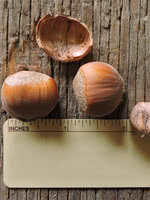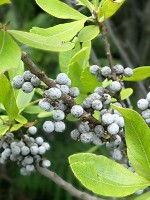Mon-Fri 9am - 5pm Mountain time
Aldara Hazelnut vs Northern Bayberry
Corylus heterophylla Het 3
Myrica pensylvanica
NOT AVAILABLE THIS SEASON - MIGHT RETURN
NOT AVAILABLE THIS SEASON - MIGHT RETURN
Aldara Hazelnut is a northern hybrid selection noted for its superior nut quality, disease resistance, and cold hardiness.
It is great for attracting wildlife with the added bonus of edible nuts that can be eaten fresh or used in baking. Pair with another Aldara or Andrew Hazelnut for cross pollination to occur.
Aldara and Andrew Hazelnut are currently the hardiest and most reliable nut varieties available for the Canadian prairies.
Note: You want more than one hazelnut to improve yields.
Northern Bayberry makes an excellent hedge or feature shrub. It will retain its leaves in warmer climates but drops them in colder areas. They produce blue-grey berries that have a wax coating on them that can be used to make candles or soaps.
In colder hardiness zones the leaves turn an attractive orange to red colour in the fall, making it a striking addition to your landscape.
Northern Bayberry is native to Nova Scotia and tolerates both drought and wet conditions. It is also a nitrogen fixer that tolerates poor soil conditions.
Aldara Hazelnut Quick Facts
Northern Bayberry Quick Facts
Toxicity: Warning: The wax from bayberry fruit is considered toxic and may be carcinogenic.

